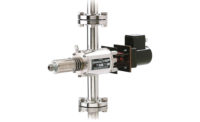Makers of insulated glass use a variety of custom machines in their production facilities. Gas filling, glass handling and glass storage machines are three of the most common types. Based in Bedford Heights, OH, Integrated Automation Systems (IAS) has been designing and manufacturing this equipment since 2010.
Initial growth at IAS was consistent and welcome. A few years ago, however, keeping up with increasing orders became a time-consuming challenge for company staff.
“It would not have been unusual for us to take four, five or even six weeks just to get ready to order the items needed to make a system,” says general manager Jim Collins. “That is a really long time just to get started.”
The reason for the bottleneck, adds Collins, was the SKU-based bill of materials (BOM) process in IAS’s accounting system. It required a worker to search through the company’s entire parts list of nearly 4,000 items, select the correct parts for the ordered system from each vendor and then type them in. This required an extensive amount of manual typing, as one machine can have 400 parts from 25 different vendors.
“We didn’t start [building] in shop for seven to eight weeks after receiving the order,” notes Collins. “By then the parts came in, [but] there was lots of wasted time.”
IAS also needed to lessen production errors and more-accurately track labor costs by system or component. To meet these challenges, IAS implemented Q2S enterprise resource planning software from FeneTech Inc.
Collins says the software has an advanced and dynamic rules-based BOM generator that readily configures and determines the price of made and shipped products in many variations. The generator enables rapid turnaround and remaking of BOM for customized or complex components and machinery. Other key benefits are easier invoicing, better tracking of similar components used in different machines, and visual manufacturing.
IAS has not needed to change its accounting system in light of Q2S. Instead, the ERP software complements QuickBooks. According to Collins, the accounting system handles accounts receivable, accounts payable and payroll, while Q2S generates all customer, vendor and production paperwork.
“We can now easily do progress invoices at times like purchase, shipment and installation,” explains Collins. “Typically, we send several invoices to a customer for a single system order, and we get hundreds from our vendors.”
Before Q2S, IAS staff had to create different part numbers for all items. The workers also simultaneously implemented their own part numbering system at the same time, which made it more complicated. The number for each item was set up just for that one customer.
“Lots of standard machine components get plugged into different machines,” says Collins. “We [also] constantly improve our equipment, which is why nothing that comes out of here is the same.”
Thanks to Q2S’s labor tracking capability, IAS has a much better idea of what each system costs to build. This is crucial, notes Collins, because the company’s manufacturing process is not linear.
“There are lots of stop and starts and bouncing between jobs,” says Collins. “We don’t make machines one at a time, so we want to know how long it takes to make something, and whether we are pricing and estimating lead times right.”
With visual manufacturing, IAS workers are getting up to speed faster and streamlining their work, acknowledges Collins. This has increased efficiency throughout production.
“We’ve reduced errors because they see the drawing and picture every step of the way,” concludes Collins. “We can make machines faster.”
For more information on enterprise resource planning software, call 330-995-2830 or visit https://q2serp.com.



